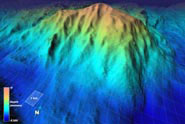|
|
||||
|
|
||||
 |
||||
|
The Atlantis Massif
From previous studies in the area (http://earthguide.ucsd.edu/mar/index.html), we have some important clues about this. First, the rocks that make up the mountain are not the usual black "basalt" that makes up most of the ocean floor. Instead the mountain is made up of a very dense green rock called "peridotite" that is usually found much deeper in the Earth in the layer called the "mantle". Somehow, this rock from deep in the Earth- at least a few miles down - has been brought to the surface and lifted up to form the Atlantis Massif. This special rock type is part of the reason that the Lost City Vents exist (see How Lost City Chimneys Form*). A second clue comes from the shape of the surface of this mountain. Over its smooth, dome-like top, there is a pattern of ridges or "corrugations" that look like a rippled tin roof or a rippled potato chip. These are probably giant scratch marks that hint that the top of the massif is a giant fault zone formed as masses of the Earth slid past one another. These pieces of evidence suggest to us that the rocks that make up the Atlantis Massif once formed under the rift valley of the Mid-Atlantic Ridge a few miles away, but were pulled out from under the rocks at the surface- like pulling a rug out from under a piece of furniture. Removing the overlying rocks had the same type of effect you can see when you remove your weight from a mattress or a couch: when the weight of overlying material is removed from the mattress, it springs up. That is why the massif is such a high mountain, the summit of which is only about half a mile below the waves. Our studies of the rocks and the shape of the mountain during our upcoming cruise to the Lost City will help us better understand how all this happened. |
||||
